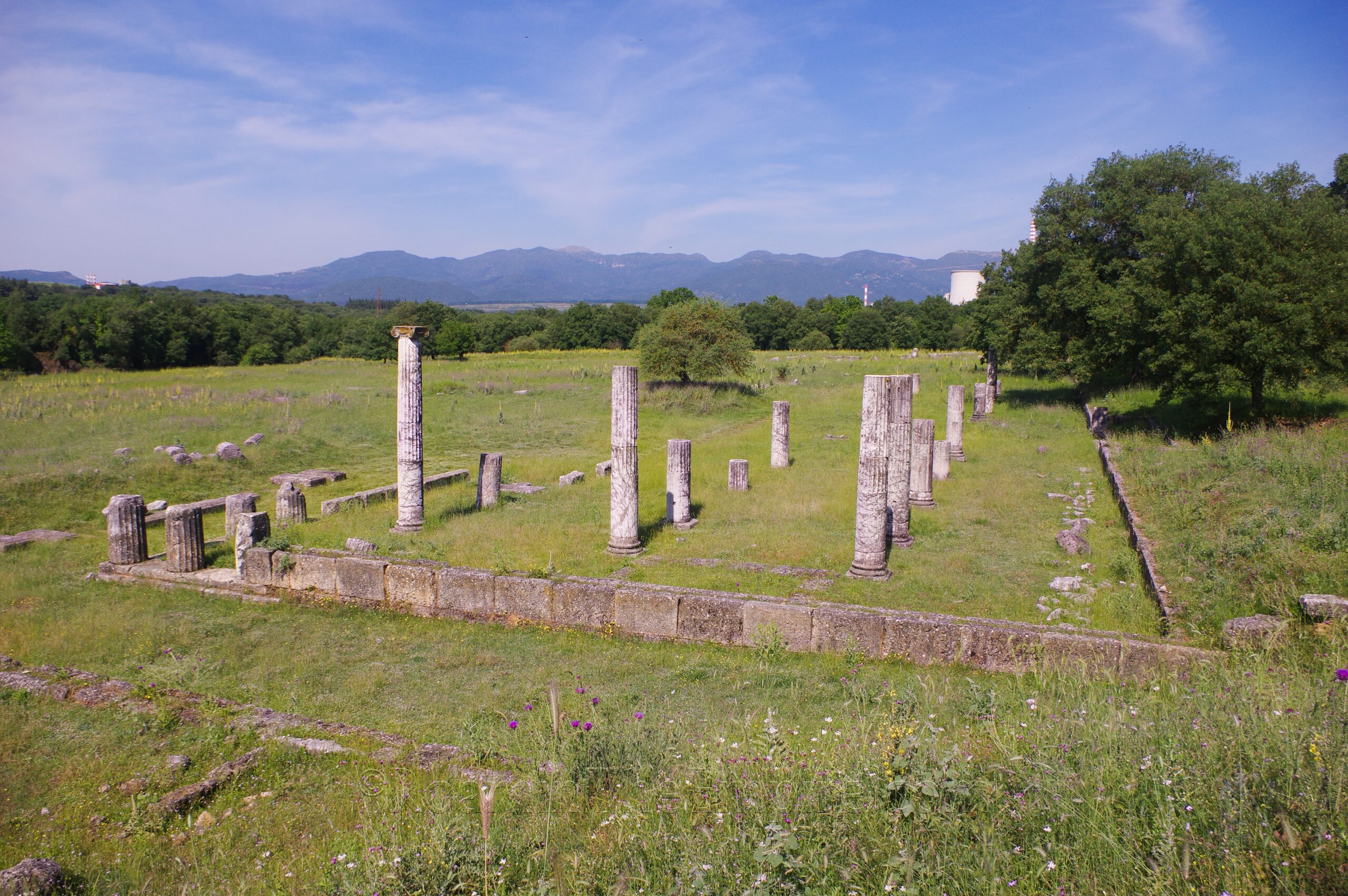
Most Recent Visit: June 2023
The ancient city of Megalopolis is today located just outside the northern limits of the modern Greek town of the same name. It was established along the banks of the Hellison (modern Elissonas) river, close to the confluence with the Alpheus (modern Alfeios). The river apparently bisected the city, rather than the city being located primarily on one bank. According to Pausanias, it was in the vicinity of Megalopolis that the mythical Gigantomachy was fought. He also mentions a spring of fire there. The combustible lignite deposits and well-known megafauna fossil beds in the area of Megalopolis may have contributed to those beliefs in antiquity.
Following the Spartan defeat at the Battle of Leuctra (or possibly shortly before) on July 6, 371 BCE, the Theban general Epimanandas sought to create a political and military opposition to Spartan hegemony in the southern Peloponnese with the re-founding of Messene and the foundation of Megalopolis. The initial population of Megalopolis was drawn from as many as 40 villages in the area which were effectively depopulated and moved to Megalopolis to form a unified political center. Shortly thereafter the League of Arcadians was re-established and Megalopolis became a member. Perhaps owing to the cosmopolitan nature of the city, Megalopolis was chosen as the meeting place of the league and hosted the council of the ten thousand.
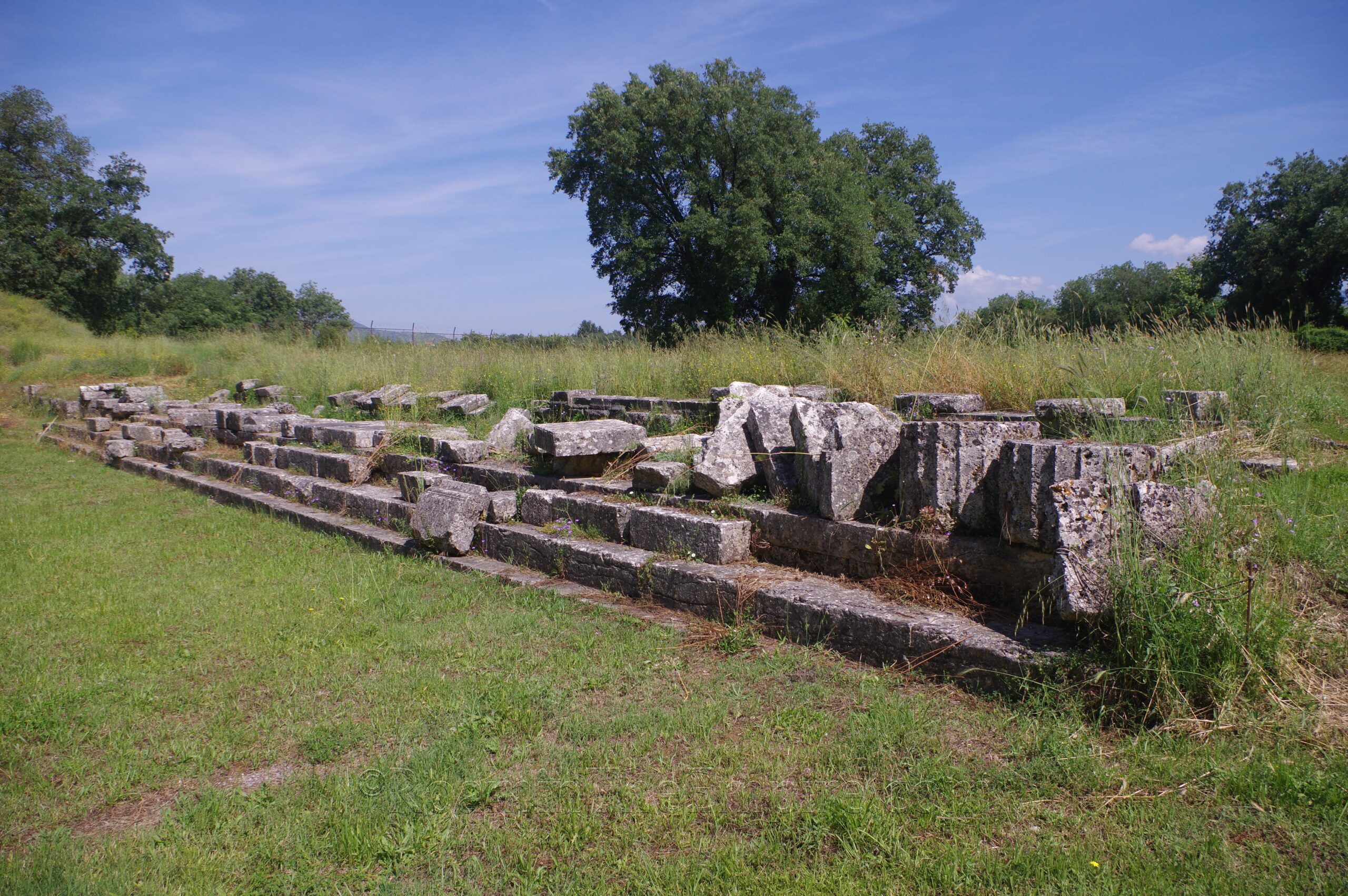
The League of Arcadians and Megalopolis’ membership in it was short-lived as it mostly dissolved following the Battle of Mantinea in 362 BCE, though it may have persisted in a limited form after the battle. The death of Epimanandas in the Battle of Mantinea and the weakening of Theban power resulted in the citizens of Megalopolis attempting to vacate the city and return to their villages, though they were prevented from doing so by Pemmenes. With their Theban allies otherwise engaged in the Third Sacred War in 353 BCE, the Spartans attempted to take Megalopolis. The attempt was foiled by eventual Theban intervention. Continued Spartan pressure caused Megalopolis to turn to Athens for help, but they were rebuffed and subsequently allied themselves with Philip II of Macedon instead. In 331 BCE, when the Peloponnese were under the hegemony of Macedonia, the Spartans rebelled against Macedonia along with other Greek cities and once again attempted to capture Megalopolis, which remained loyal to the Macedonians. The Spartans, led by King Agis III, were defeated and their king killed at the Battle of Megalopolis that same year by Alexander the Great’s regent, Antipater.
During the Second War of the Diodochi, Megalopolis sided with Cassander and as a result was besieged by Polyperchon in 318 BCE. The attackers managed to breach the walls of the city, but they were eventually driven back by the inhabitants of Megalopolis under the command of an officer named Damis. By the middle of the 3rd century BCE, Megalopolis was under the rule of tyrants, the first of which was Aristodemus the Good, who installed by the Macedonians. During his rule, circa 262 BCE, Megalopolis was once again attacked by the Spartans. The Spartans were defeated and their king, Acrotatus, was killed in the encounter. The final tyrant was Lydiades, who abdicated his position and brought Megalopolis to the Achaean League in 232 BCE. Again in 222 BCE, the Spartan king Cleomenes III led a successful attack against the city. Most of the population was able to escape, but the city itself was mostly destroyed by the Spartans.
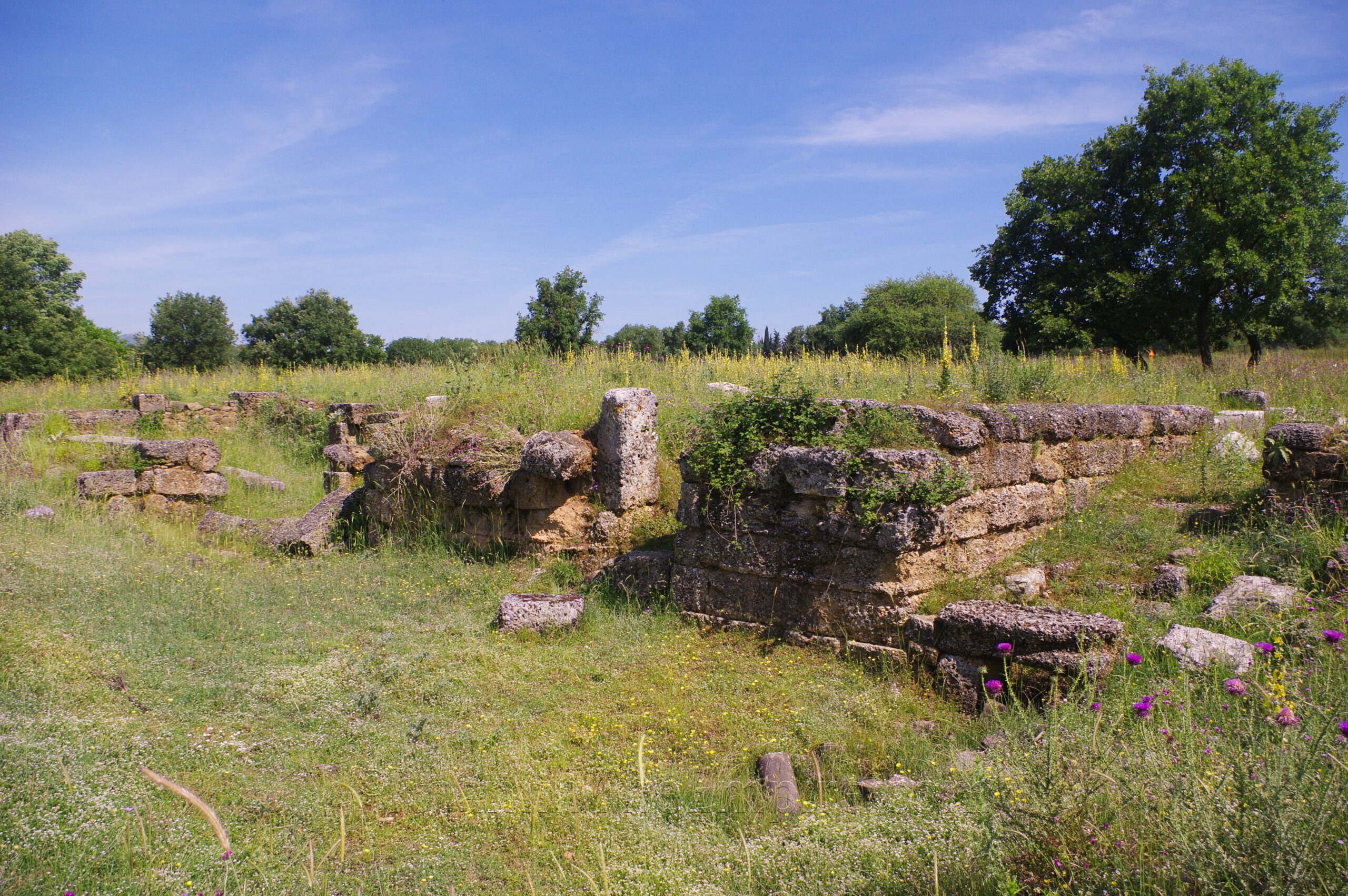
Megalopolis never quite flourished in meaningful way and failed to live up to the lofty name it was given. When it came time to rebuild the city after the Spartan destruction, it was proposed that the city walls were contracted as they encompassed more territory than needed. The proposal failed and the original circuit was restored. The historian Polybius, who was born in Megalopolis around 200 BCE, would later note that the city was half the population of Sparta but was twice the size. The city was once again subject to Spartan aggression circa 205 BCE at the hands of Nabis, but the walls held and spared the city any serious damage. Just a few decades later around 175 BCE, the walls had apparently fell into disrepair and the Seleucid king Antiochus IV Epiphanes is recorded as having offered the money to have them repaired.
Megalopolis fell under Roman control after the defeat of the Achaean League in 146 BCE. The last strategos of the league was Diaeus of Megalopolis, who following his defeat at the Battle of Corinth, returned to his hometown and committed suicide. The city continued to be inhabited through the Roman period, though later writers such as Strabo and Pausanias would describe Megalopolis as deserted (perhaps owing to the excess of space within the walls) and in decline (though still among the largest cities in Arcadia). It would remain a population center until the 6th century CE, at which time the population dispersed.
Getting There: Modern Megalopolis isn’t a particularly large town, the population of the entire municipality is less than 10,000. There is no train service and even bus service seems fairly limited; perhaps a bus or two a day between Megalopolis and Athens according to the KTEL Arcadia site. A private vehicle is the easiest and most flexible way of getting to Megalopolis and to the archeological areas north of the city.
The remains of ancient Megalopolis are contained within two archaeological areas on either side of the Elissonas, located just off the Eparchiaki Odos Megalopolis Andritsenas (76) leading north out of the modern town. The first area on the south side of the river is the archaeological area of the ancient theater. The theater is currently closed (as of 2025) for renovations (the preparations of which were pretty clear even when I visited) with an expected reopening of 2027. Before it closed for the renovations, it was open daily except for Tuesdays from 8:30 to 15:30. Admission was free.
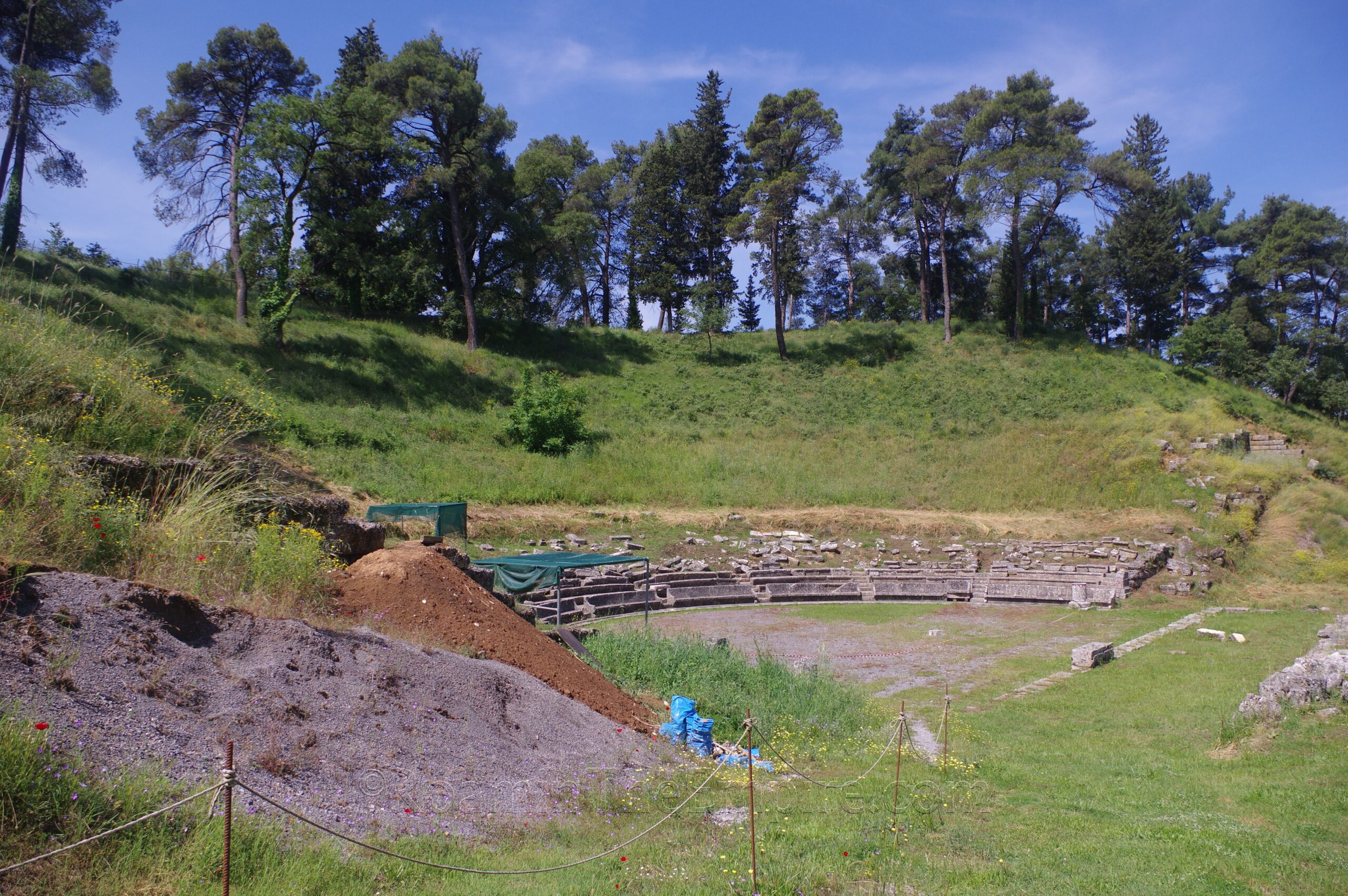
The theater was originally constructed shortly after the founding of the city, sometime between 370 and 360 BCE. Around 300 BCE, a major renovation occurred in which stone seating replaced the earthen slope on which the audience originally sat. According to Pausanias, it was the largest theater in all of Greece, and is estimated to have held between 17,000 and 20,000 spectators. The stone theater consisted of an estimated 55 to 60 rows of seating, though only the first 7-8 rows are still extant and visible. The form of the orchestra and a drainage channel around the front row of seats are visible. The front row of seating had a rear support and were more ornate than the others, as these seats were reserved for dignitaries. None of the seating or main area of the theater was accessible when I visited.
The scenea of the theater lead up via a monumental staircase and entrance into a rectangular structure north of the theater that is identified as the Thersilion, the council house for the ten thousand of the League of Arcadians. By Pausanias’ time, the structure was no longer in use and he notes that it was only the foundations of the building that remained. The Thersilion was named after the donor responsible for its construction. The building was a large hall with internal colonnades. Unfortunately the area was mostly overgrown when I visited, but there were some areas cleared in which the column bases of the internal colonnade were visible. There is one informational sign in Greek and English that give a plan and information in Greek and English on the theater and Thersilioin.
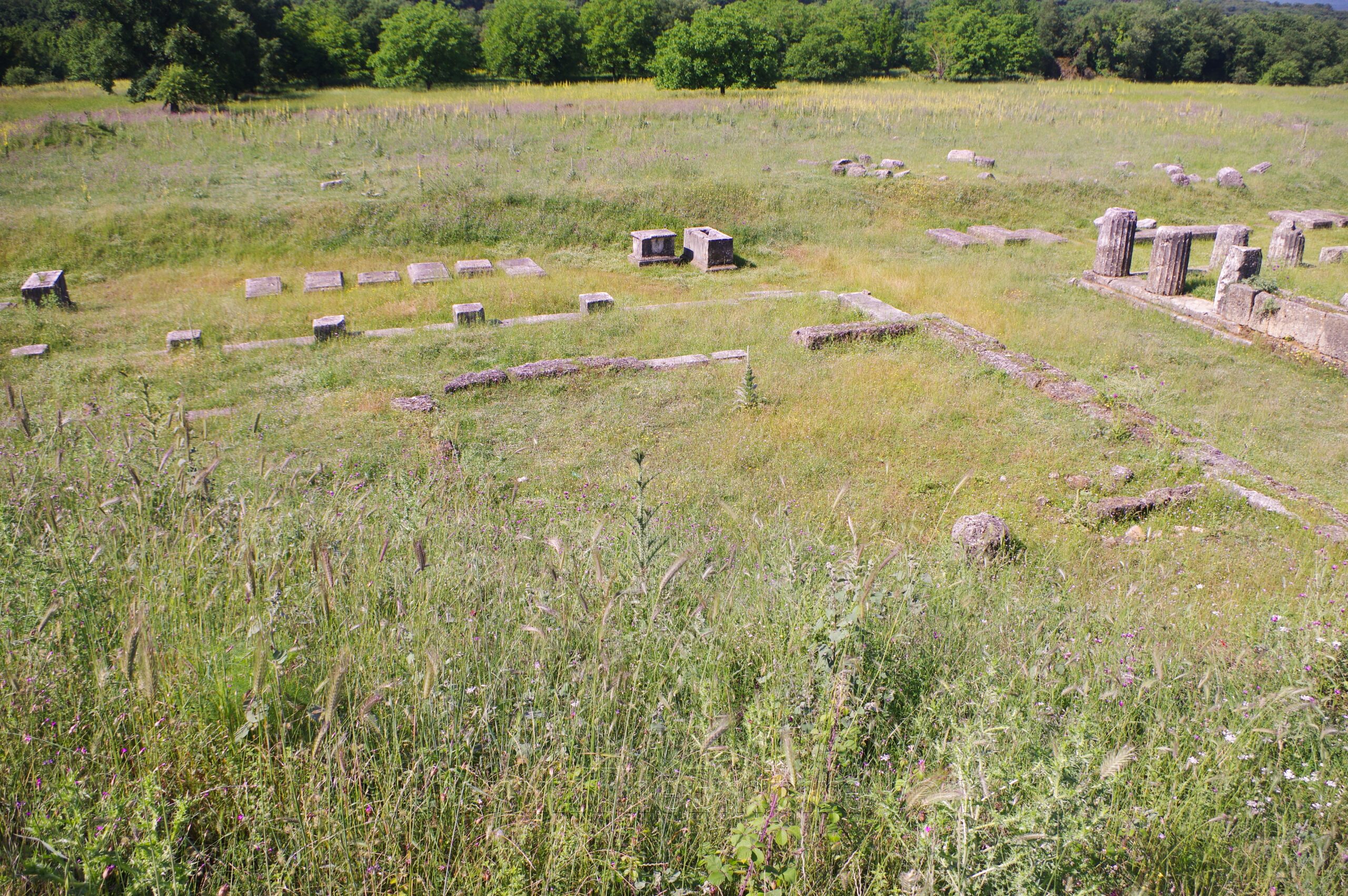
Continuing north on the Eparchiaki Odos Megalopolis Andritsenas, about 250 meters after the bridge over the Elissonas is the entrance to the other archaeological area of Megalopolis. If the grass is cut, there’s some room to park near this entrance, but otherwise there is a little more shoulder space another 150 meters up there road. This archaeological area is supposedly open the same hours as the theater, Wednesday through Sunday from 8:00 to 15:30, but the area is unattended, so it may or may not actually ever be closed.
This archaeological area encompasses the agora of ancient Megalopolis. Even when overgrown, there’s a path that heads off toward the northeast from the entrance to the north side of the agora. The building at the very northeast of the agora is identified as being the archives. Pausanias describes these as government offices containing six rooms. He notes that one of these rooms hosted a statue of Ephesian Artemis and another a bronze statue of Pan that was called Scoleitas. Only a small corner of this is visible as it is overlaid by the modern road.
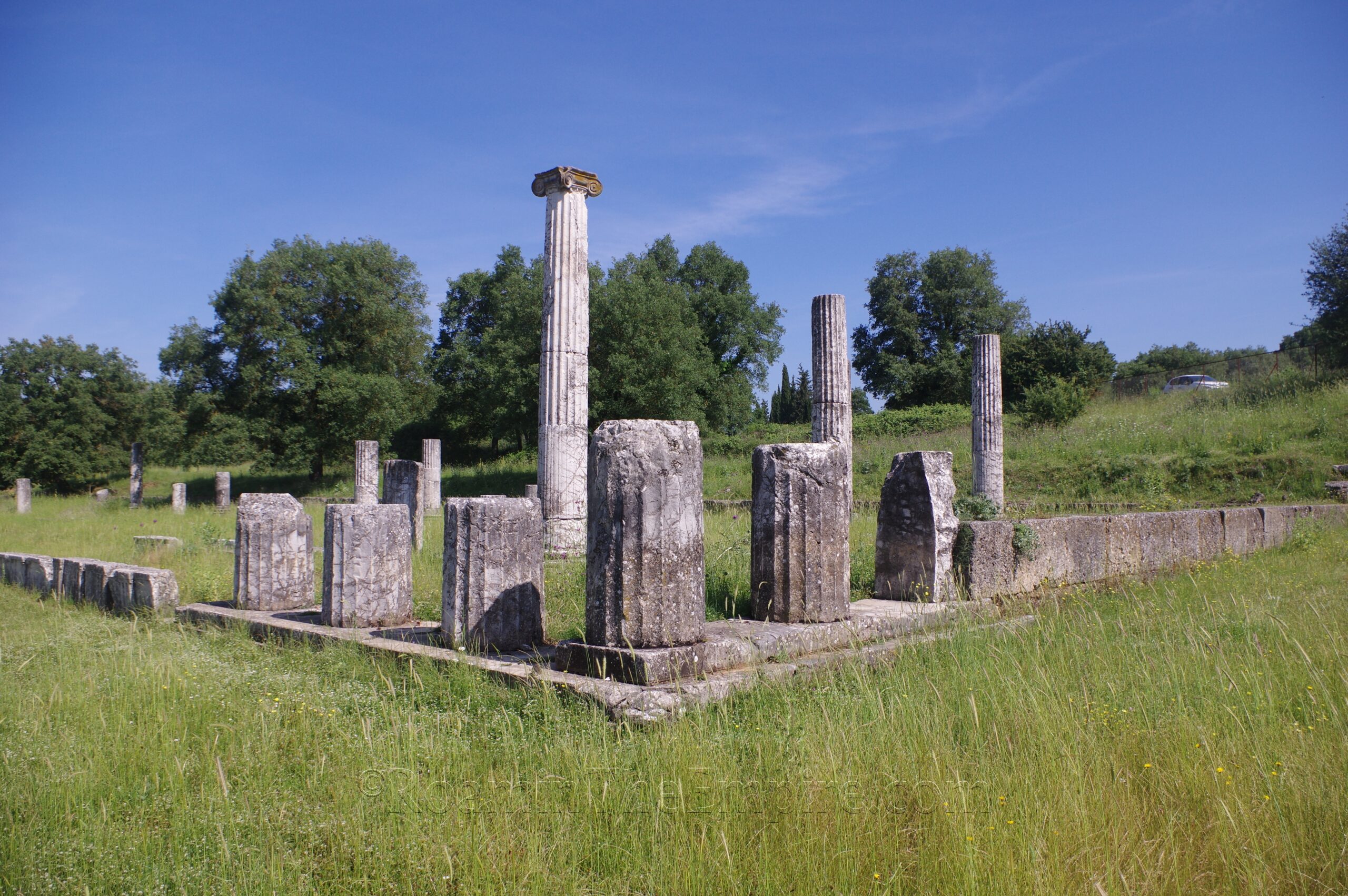
Next to this, occupying the entire west half of the northern side of the agora, is the so-called Stoa of Philip, which Pausanias refers to as the Philippeum. The building was not constructed by Philip, but was rather named in honor of Philip II of Macedon by the people of Megalopolis. As the name would suggest, it was probably constructed around 340 BCE, as Megalopolis sought the support of Macedonia. It was then likely reconstructed after a destruction in the Spartan sack of the city in 222 BCE. The 155 meter long stoa is probably the best preserved building in the agora. Pretty much the entirety of the stoa is excavated and a number of columns are standing in the eastern part of the building. The east and west ends are particularly well preserved with lots of structural detail. Also along the east end of the stoa as well as the archive building are the bases of several monuments that would have lined the open area of the agora.
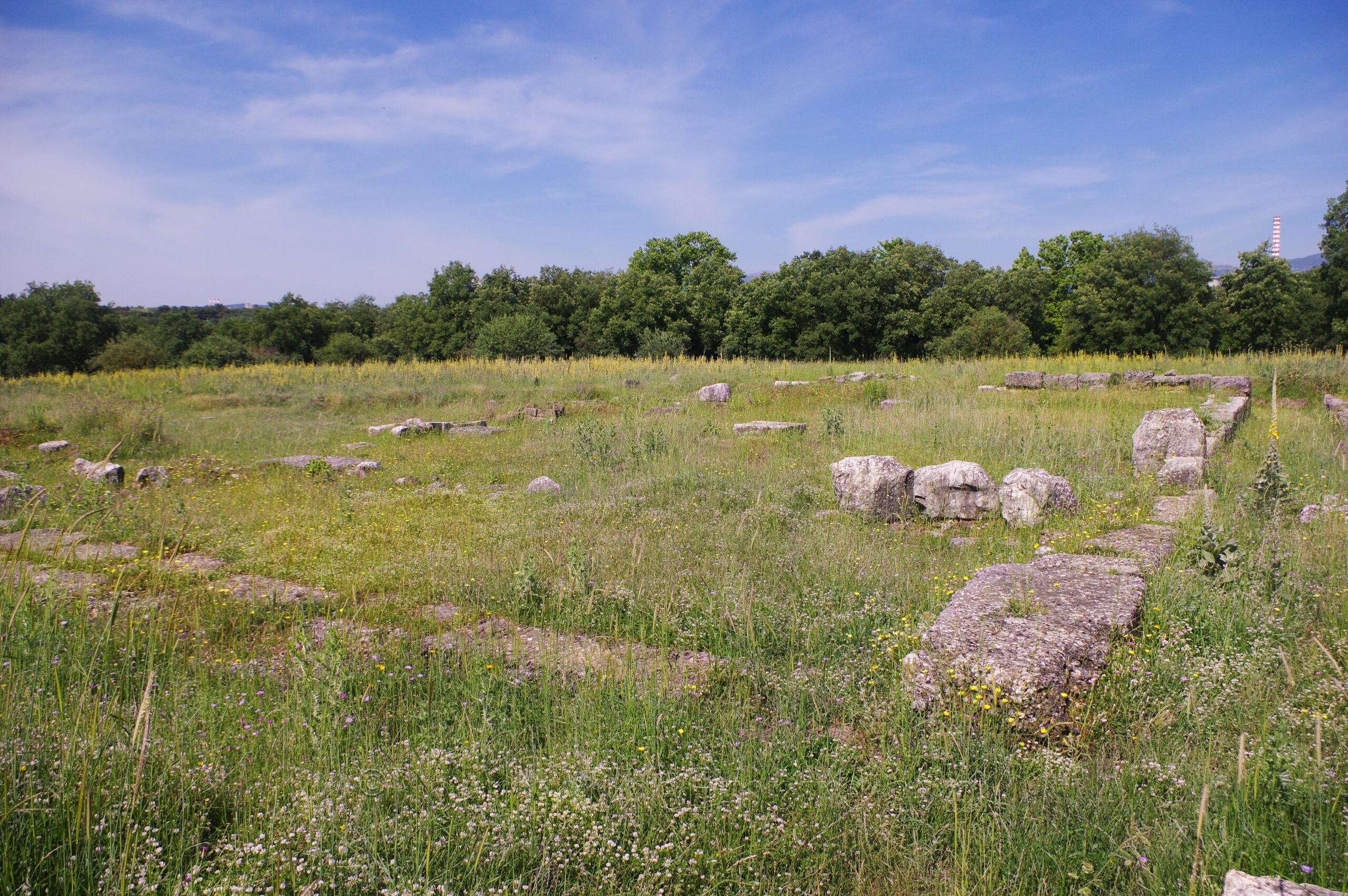
South of the west side of the Stoa of Philip are a series of buildings that enclosed the west end of the agora. The northernmost of these is a hypostyle hall that has been identified as the bouleuterion of the city. It was probably originally constructed in the mid-4th century BCE, damaged in the destruction of 222 BCE, and then rebuilt in the middle of the 2nd century BCE. South of this is a peristyle courtyard building called the damosia okia, a public administration building. It too was rebuilt in the 2nd century BCE and also received a significant reconstruction and renovation during the Roman period. The southernmost of the three buildings is a small hall in which hundreds of tiles stamped with the names of benefactors involved in the reconstruction of the building following it’s 222 BCE destruction, including the historian Polybius and the general Philopeomen. The use of the building is unclear, but it may have been a sanctuary space dedicated to Zeus or the prytaneion.
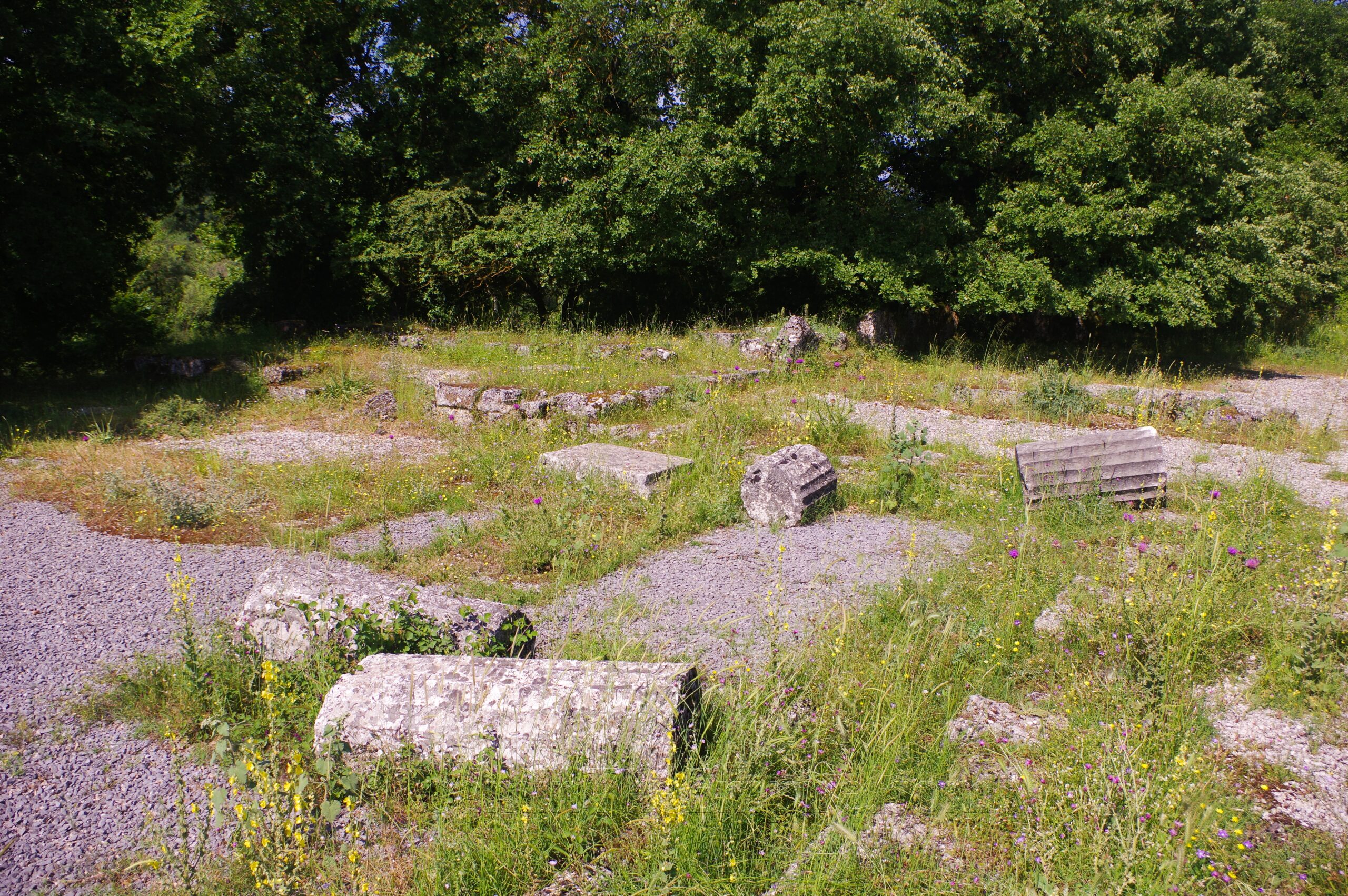
Much of the southern side of the agora has been destroyed by the shifting path of the Elissonas, aside from the northern part of one building at the southeast corner, the sanctuary of Zeus Soter. This sanctuary with a porticos, monumental entrances, and a temple located on the western side was constructed toward the end of the 4th century BCE. Pausanias writes that the temple contained three cult statues; an enthroned Zeus Soter, Artemis Soteira, and the personification of Megalopolis. These were sculpted by the Athenian sculptors Cephisodotus and Xenephon.
Thirty-five meters northeast of the sanctuary of Zeus Soter are the scant remains of the southern side of the Stoa of Myropolis. According to Pausanias, this stoa was constructed in the 3rd century BCE by the tyrant Aristodemos with spoils from his victory over Acrotatus around 262 BCE. Much of the stoa is unexcavated, but it seems to have made up almost the entirety of the east side of the agora. Even the small bit that was excavated was significantly more overgrown than other parts of the site.
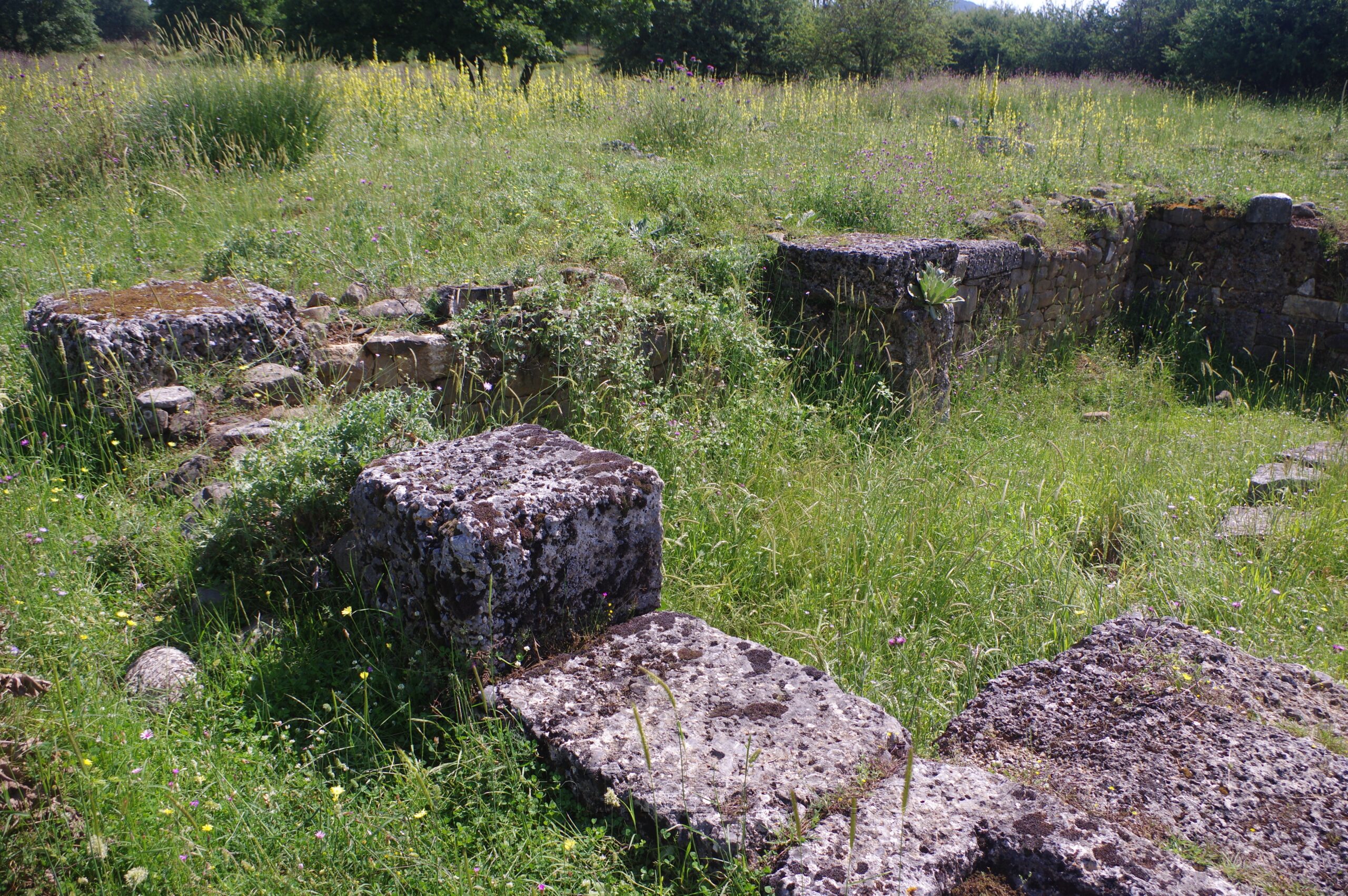
There’s no information in the archaeological area or really any kind of identifying signage. It’s pretty much just presented as is without any context, which is kind of a shame. It was somewhat overgrown, but not too bad when I visited. The theater really just takes a few minutes and this archaeological area maybe a half an hour to 45 minutes, so really all of Megalopolis can be done in about an hour. Hopefully the renovations at the theater will also lead to better development of the agora archaeological area. I’ve seen references to there being an archaeological museum located in Megalopolis, but this does not seem to exist anymore. The finds from Megalopolis seem to be in the regional museum in Tripoli, which itself was only partially open. In all, Megalopolis makes for a decent stop in the area, but could certainly be a much more attractive point of interest with a little development.
Sources:
Diodorus Siculus. Bibliotheca Historica, 15.72.4, 15.94, 16.39, 18.68-74, 19.64.1.
Donati, Jamieson C. “The Greek Agora in its Peloponnesian Context(s).” Classical Archaeology in Context: Theory and Practice in Excavation in the Greek World, Donald C. Haggis and Carla Antonaccio (eds.), Boston:De Gruyter, 2015.
Grant, Michael. A Guide to the Ancient World: A Dictionary of Classical Place Names. New York: Barnes & Noble Books, 1997.
Livy. Ab Urbe Condita, 32.22, 38.34, 41.20-24.
Mayor, Adrienne. The First Fossil Hunters: Dinosaurs, Mammoths, and Myth in Greek and Roman Times. Princeton: Princeton University Press, 2000.
Pausanias. Hellados Periegesis, 2.27.5, 4.29.7-10, 5.7.1, 6.12.8, 7.6-16, 8.27, 8.29.1, 8.30-33.
Plutarch. Agis, 3.2-3.4.
Plutarch. Aratus, 36-38.
Plutarch. Cleomenes, 4.1-12.2, 23-29, 37.6.
Plutarch. Philopoemen, 1-21.
Polybius. Historiae, 2.46-68, 4.6-13, 4.32-37, 4.80-82, 5.91-94, 9.26, 21.9.1, 31.1.6.
Smith, William. Dictionary of Greek and Roman Geography. Walton & Murray, 1870.
Stillwell, Richard, William L. MacDonald, and Marian Holland. McAllister. The Princeton Encyclopedia of Classical Sites. Princeton, NJ: Princeton U Press, 1976.


